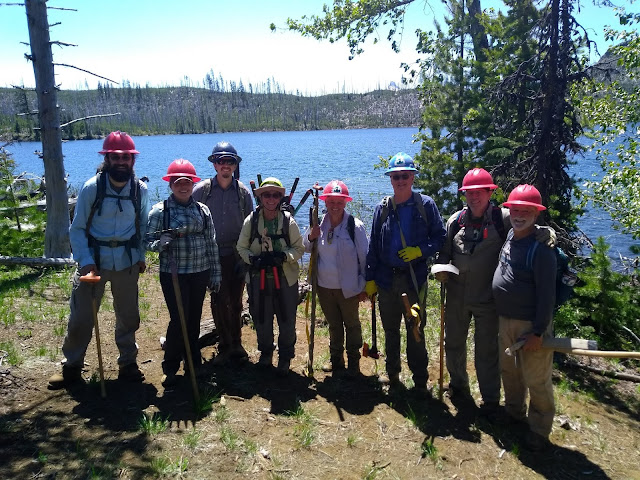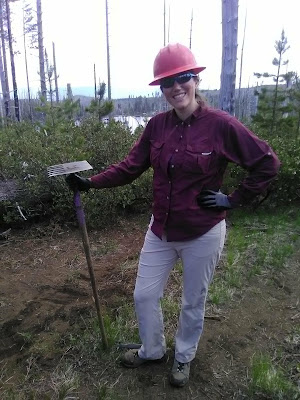 |
| Zach and I tackle a downed log |
After the harrowing first day of classes, Zach and I were both ready to tackle the much-tamer Trail Maintenance 101, which would focus on "brushing"— clearing the trail for both hiker and equestrian use. The day began with an elaborate breakfast, prepared by an equestrian group who had set up a huge pavilion and served eggs, sausage, hash, fruit salad, and oatmeal. A delicious start to the day! We wolfed down the food, then met at a gravel parking lot to see who would be in our class with us.
The entire trail class was close to 30 people, but we split into three groups, and we'd divide further to hop into Forest Service trucks to head out to a trail for some hands-on experience.
Our group leaders were Dave, a Forest Service Ranger about our age who had backpacked more miles than I can dream, and Jim and Ginny, an older couple who had spent their lives in service of the wilderness. Our class also included search-and-rescue expert Sue, former Bureau of Land Management worker Bob, a sweet guy named Mark that I never got to talk to, and a young woman named Natalie who had thru-hiked the PCT last year. Dave, Bob, Natalie, and we crammed into a truck together, comparing notes on our hikes while Bob peppered us with questions and Dave fishtailed up some ridiculously bumpy dirt roads.
 |
| Zach, Natalie, Dave, Sue, Ginny, Jim, Bob, and Mark at Square Lake |
We ended up near the creatively-named Round Lake, which settled into the folds of hills that had been burned down to the mineral soil 16 years earlier. The hills were blanketed with manzanita, beargrass, and brush, along with lodgepole pines racing to reclaim the canopy. Blackened spears of trees stuck up everywhere, reminding me that forests take a very long time to regrow.
 |
| Jim helping Zach cut out a lodgepole pine |
Although the night had been chilly, it was searingly hot as we regrouped at the sunny trailhead to discuss safety and the function of the various tools: hazel hoe, Pulaski, McCloud, hand saw, loppers, shovel. I had used most of the tools before, and had a bit of experience with brushing from our last volunteer trip, but it was good to review.
Decked out in hard hats, long sleeves, sunglasses, and work gloves, we each grabbed a couple tools and began slowly walking up the trail, stopping almost immediately to discuss the brush situation and clip back some manzanita. We inched up the trail, brushing and discussing as we went, pausing to cut out some young lodgepoles growing too close to the trail, then moving on.
A family riding horses passed us, then after a little while returned, saying that fallen logs were blocking the trail up ahead. Dave asked how big the logs were, and after the riders had left, he and Jim and Ginny discussed it while we worked. Since we were in a designated wilderness area, motors— and therefore chainsaws— were not allowed. Someone would have to crosscut-saw the logs.
We spent a solid couple hours sweating through the brush clearing, at last stopping for lunch on a pile of dead logs. I was dearly wishing for some live trees to offer shade, and chugged my water.
Our crew leaders said that we seemed pretty competent on brushing, so they went ahead and dived into part two of the trail maintenance class: drainage and grading. A properly-formed trail needs little maintenance, won't turn into ruts, and won't wear out, and good drainage areas are essential for this. We started walking back down the way we'd come, this time imagining ourselves as drops of water eager to erode the trail. Where could we be diverted to avoid damaging and wearing out the trail?
Again, Zach and I had worked on this concept before, and soon everyone in the group had picked it up fairly well, scraping and forming the ground, widening existing drains, reshaping others. Once you start getting "trail eyes," it's hard to go back— now I feel like a drop of water every time I set foot on a trail.
 |
| Me with my favorite tool, the McCloud |
Due to the heat, class ended early that day, but not before they promised us that we would introduce a new element tomorrow, one that wasn't supposed to be included in this class: crosscut sawing! Zach and I had both been very interested in learning more about crosscut, so we were excited. Plus, the thought that we'd be doing something tangible to make this trail more accessible was cool.
We had plenty of time to relax and hike along the river that afternoon, and then after a delicious dinner that night, we sat through a ceremony in which the organizers thanked the volunteers who made the college happen, the various trail organizations in attendance talked about their work, and they called out trivia questions so people could earn prizes. (I correctly remembered one of the acronyms from First Aid and won a PCTA tote bag.)
We were up and at 'em early the next day, treated to another hearty breakfast. We piled into the same truck with the same group of people and wound up the mountainside, chatting about trail experiences and asking stories.
Once at the trail, we reviewed some of the previous day's work (they had brought a tennis ball, which they'd drop on the trail— it demonstrated how water would flow on the trail and whether the drainage slots we'd widened were sufficient), then tromped onward to find the fallen logs that the riders had noted.
The trail was wide open and green, with wonderful views of snowy mountains in all directions— Three-Fingered Jack, Washington, and the Three Sisters. Today was less hot, even though I was still sweating from wearing long sleeves. As we hiked, we chatted with Dave about his backpacking trips— the Pacific Crest, the Continental Divide, and a long-distance trail in Patagonia— and compared notes with him and Natalie about the PCT.
At last we came to the first of what turned out to be 11 downed logs over the trail— the burned trees, standing placidly for 16 years, had finally given up the ghost. Jim and Ginny unpacked the crosscut blades and screwed on the handles, and we discussed all the factors to consider before starting to cut (which were tucked into yet another acronym, and a convoluted one at that). Working with big logs can be dangerous in many different ways!
 |
| Zach and Mark on crosscut |
Finally it was time to cut, and we took turns, subbing in and out. At worst it felt like a really bad game of tug-o-war, but when the other sawyer and I were in sync, it took hardly any effort and the tension of the saw felt just right, like it was moving back and forth on its own and I was just guiding it. Dave pointed out the "noodles" of cut wood falling out under the blade, indicating that we were cutting smoothly.
After several minutes of working our way through the 14-inch log, the first cut was made, which I finished with a handsaw. Dave said that experienced sawyers could cut a log this size in less than a minute!
We worked our way through 11 logs that day, completely clearing the trail all the way up to the nearest junction. We paused late in the afternoon for lunch by the glittering shore of Square Lake, where— hallelujah!— some mature trees had survived to give us shade. Then we hiked out, reviewing our work, loudly congratulating each other on each cut log that we passed, and feeling like we had gained some valuable field experience.
We did a quick debriefing, and then dispersed, graduates of the college that had given us some valuable new skills. Zach and I met up with Gary at the campsite, where we'd stay one more night before heading to Bend in the morning. As we toasted marshmallows that night, I felt satisfied— the weekend had been a success!
~~~
No comments:
Post a Comment